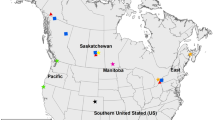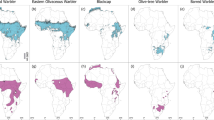Abstract
Rufous Hummingbirds (Selasphorus rufus) undertake an annual migration between breeding grounds in western North America and wintering grounds in south-central Mexico, with a small wintering population on the Gulf Coast of the USA. However, little is known about the pattern of connectivity between the breeding and wintering grounds for this species. The aim of the study was to explore migratory connectivity in S. rufus, using feather deuterium (δ 2 H). Selasphorus rufus molt on the wintering grounds, so newly-grown feathers of adult birds carry an isotopic signature characteristic of the overwintering area. Tail feathers were collected from 229 adult birds from six breeding sites located in British Columbia and Alberta, Canada, and Alaska, USA. The δ 2 H signatures of feathers from birds at each site were used for geospatial allocation of wintering range onto one amount-weighted δ 2 H precipitation isoscape (North America) and one shallow groundwater δ 2 H isoscape (Mexico), using reduced major axis regression. The relationship between feather δ 2 H (δ 2 H f ) and amount-weighted precipitation δ 2 H (δ 2 H p ) in S. rufus was tighter than that found in other avian taxa to date, and is comparable to that reported previously for the Ruby-throated Hummingbird (Archilochus colubris). At three of the breeding sites, males showed significantly higher δ 2 H f values compared to females, suggesting possible allopatric separation (with an altitudinal component) on the wintering grounds. This pattern did not hold for the two most easterly breeding sites. For female birds at the three western breeding sites, the predicted wintering area lies at higher altitude in Mexico than for birds from the breeding sites further east. For male birds, there was a less marked difference in δ 2 H f between most of the breeding sites, although it is likely that birds from the western breeding sites share overwintering range, and that those from the eastern breeding sites overwinter at lower elevations.
Zusammenfassung
Eine Untersuchung der Zug-Konnektivität der Rotrücken-Zimtelfe, Selasphorus rufus , mittels Deuterium in den Federn
Rotrücken-Zimtelfen (Selasphorus rufus) ziehen jährlich zwischen Brutgebieten in Nordamerika und Überwinterungsgebieten in Südzentralmexiko; eine kleine Population überwintert am Golf der USA. Nur wenig ist jedoch über das Muster der Konnektivität zwischen Brut- und Überwinterungsgebiet bei dieser Art bekannt. Ziel dieser Studie war es, die Zug-Konnektivität der Rotrücken-Zimtelfe mittels Deuterium in den Federn (δ2H) zu untersuchen. Rotrücken-Zimtelfen mausern im Überwinterungsgebiet, weshalb neu gewachsene Federn von Altvögeln eine für das Überwinterungsgebiet charakteristische Isotopensignatur aufweisen. Wir sammelten Schwanzfedern von 229 Altvögeln in sechs Brutgebieten in Britisch-Kolumbien und Alberta, Kanada, sowie in Alaska, USA. Die δ2H-Signaturen der Federn von Vögeln aus jedem Gebiet wurden herangezogen, um eine georäumliche Zuordnung des Überwinterungsgebiets zu einer mengengewichteten δ2H-Niederschlags-Isotopenlandschaft (Nordamerika) und einer oberflächennahes-Grundwasser-δ2H-Isotopenlandschaft (Mexiko) mittels einer Hauptachsenregression durchzuführen. Die Beziehung zwischen Feder-δ2H (δ2Hf) und mengengewichtetem Niederschlags-δ2H (δ2Hp) bei der Rotrücken-Zimtelfe war enger als die bislang bei anderen Vogeltaxa gefundenen und ist vergleichbar mit der zuvor für den Rubinkehlkolibri (Archilochus colubris) gezeigten Beziehung. In drei der Brutgebiete hatten Männchen signifikant höhere δ2Hf -Werte als Weibchen, was auf eine mögliche allopatrische Trennung (mit einer Höhenkomponente) im Überwinterungsgebiet hindeutet. Dieses Muster galt nicht für die beiden östlichsten Brutgebiete. Das für Weibchen aus den drei westlichen Brutgebieten vorhergesagte Überwinterungsgebiet in Mexiko ist höher gelegen als das für Vögel aus den weiter östlichen Brutgebieten. Für Männchen war der Unterschied in δ2Hf zwischen den meisten Brutgebieten weniger stark ausgeprägt, wobei die Überwinterungsgebiete der Vögel aus den westlichen Brutgebieten wahrscheinlich überlappen und Männchen aus den östlichen Brutgebieten in niedriger gelegenen Gebieten überwintern.



Similar content being viewed by others
References
Altshuler DL (2006) Flight performance and competitive displacement of hummingbirds across elevational gradients. Am Nat 167:216–229
Bacon I, Hurly TA, Healy SD (2011) Hummingbirds choose not to rely on good taste: information use during foraging. Behav Ecol 23:471–477. doi:10.1093/beheco/arr002
Bassett F, Cubie D (2009) Wintering hummingbirds in Alabama and Florida: species diversity, sex and age ratios, and site fidelity. J Field Ornithol 80:154–162
Bateson M, Healy SD, Hurly TA (2003) Context-dependent foraging decisions in rufous hummingbirds. Proc R Soc Lond B 270:1271–1276
Bohonak AJ (2004) RMA: software for reduced major axis regression. San Diego State University, San Diego
Boulet M, Norris DR (2006) The past and present of migratory connectivity. Ornithol Monogr 61:1–13
Bowen GJ, Revenaugh J (2003) Interpolating the isotopic composition of modern meteoric precipitation. Water Resour Res 39:1299. doi:10.1029/2003WR002086
Bowen GJ, Wassenaar LI, Hobson KA (2005) Global application of stable hydrogen and oxygen isotopes to wildlife forensics. Oecologia 143:337–348
Calder WA (2004) Rufous and broad-tailed hummingbirds. Pollination, migration, and population biology. In: Nabhan GP (ed) Conserving migratory pollinators and nectar corridors in Western North America. University of Arizona Press, Tucson, pp 59–79
Chamberlain CP, Blum JD, Holmes RT, Feng X, Sherry TW et al (1997) The use of isotope tracers for identifying populations of migratory birds. Oecologia 109:132–141
Ehleringer JR, Phillips SL, Schuster WSF, Sandquist DR (1991) Differential utilization of summer rains by desert plants. Oecologia 88:430–434
Flanagan LB, Bain JF, Ehleringer JR (1991) Stable oxygen and hydrogen isotope composition of leaf water in C3 and C4 plant species under field conditions. Oecologia 88:394–400
Fraser KC, Diamond AW, Chavarria L (2010) Evidence for altitudinal moult-migration in a Central American hummingbird, Amazilia cyanura. J Trop Ecol 26:645–648
Guillemain M, Hearn R, King R, Gauthier-Clerc M, Simon G et al (2009) Differential migration of the sexes cannot be explained by the body size hypothesis in teal. J Ornithol 150:685–689
Hardesty JL, Fraser KC (2010) Using deuterium to examine altitudinal migration by Andean birds. J Field Ornithol 81:83–91
Hobson KA (2008) Using endogenous and exogenous markers in bird conservation. Bird Conserv Int 18:S174–S199
Hobson KA, Norris DR (2008) Animal migration: a context for using new techniques and approaches. In: Hobson KA, Wassenaar LI (eds) Tracking animal migration with stable isotopes. Academic Press, London, pp 1–19
Hobson KA, Wassenaar LI, Mila B, Lovette I, Dingle C et al (2003) Stable isotopes as indicators of altitudinal distributions and movements in an Ecuadorean hummingbird community. Oecologia 136:302–308
Hobson KA, Lormée H, Van Wilgenburg SL, Wassenaar LI, Boutin JM (2009a) Stable isotopes (δD) delineate the origins and migratory connectivity of harvested animals: the case of European woodpigeons. J Appl Ecol 46:572–581
Hobson KA, Van Wilgenburg SL, Larson K, Wassenaar LI (2009b) A feather hydrogen isoscape for Mexico. J Geochem Explor 102:63–70
Hurly TA, Franz S, Healy SD (2010) Do rufous hummingbirds (Selasphorus rufus) use visual beacons? Anim Cogn 13:377–383
Hutcheson C, Hendrix L, Moran JA (2010) An isotopic analysis of migratory connectivity in ruby-throated hummingbirds. N Am Bird Bander 2010:5–11
Jenkins KD, Cristol DA (2002) Evidence of differential migration by sex in white-throated sparrows (Zonotrichia albicollis). Auk 119:539–543
Kodric-Brown A, Brown JH (1978) Influence of economics, interspecific competition, and sexual dimorphism on territoriality of migrant rufous hummingbirds. Ecology 59:285–296
Komar O, O’Shea BJ, Peterson T, Navarro-Sigüenza AG (2005) Evidence of latitudinal sexual segregation among migratory birds wintering in Mexico. Auk 122:938–948
Langin KM, Reudink MW, Marra PP, Norris DR, Kyser TK et al (2007) Hydrogen isotopic variation in migratory bird tissues of known origin: implications for geographic assignment. Oecologia 152:449–457
Lott CA, Smith JP (2006) A geographic-information-system approach to estimating the origin of migratory raptors in North America using stable hydrogen isotope ratios in feathers. Auk 123:822–835
Luo Y, Sternberg L (1991) Deuterium heterogeneity in starch and cellulose nitrate of CAM and C3 plants. Phytochemistry 30:1095–1098
Myers JP (1981) A test of three hypotheses for latitudinal segregation of the sexes in wintering birds. Can J Zool 59:1527–1534
Prinzinger R, Schäfer T, Schuchmann K-L (1992) Energy metabolism, respiratory quotient and breathing parameters in two convergent small bird species: the fork-tailed sunbird Aethopyga christinae (Nectariniidae) and the chilean hummingbird Sephanoides sephanoides (Trochilidae). J Therm Biol 17:71–79
Schondube JE, Contreras-Martínez S, Ruan-Tejeda I, Calder WA, Santana E (2004) Migratory patterns of the rufous hummingbird in Western Mexico. In: Nabhan GP (ed) Conserving migratory pollinators and nectar corridors in Western North America. University of Arizona Press, Tucson, pp 80–95
Schwinning S, Davis K, Richardson L, Ehleringer JR (2002) Deuterium enriched irrigation indicates different forms of rain use in shrub/grass species of the Colorado Plateau. Oecologia 130:345–355
Sokal RR, Rohlf FJ (1981) Biometry: the principles and practice of statistics in biological research, 2nd edn. Freeman, New York
Wassenaar LI, Hobson KA (2003) Comparative equilibration and online technique for determination of non-exchangeable hydrogen of keratins for use in animal migration studies. Isotop Environ Health Stud 39:211–217
Wassenaar LI, Van Wilgenburg SL, Larson K, Hobson KA (2009) A groundwater isoscape (δD, δ 18O) for Mexico. J Geochem Explor 102:123–136
Webster MS, Marra PP, Haig SM, Bensch S, Holmes RT (2002) Links between worlds: unraveling migratory connectivity. Trends Ecol Evol 17:76–83
Wolf N, Bowen GJ, del Rio M (2011) The influence of drinking water on the δD and δ 18O values of house sparrow plasma, blood and feathers. J Exp Biol 214:98–103
Acknowledgments
Two anonymous reviewers helped to improve the manuscript considerably. We also thank the following people for their help with the project: S. Acton, I. Bacon, G. Baluss, C. Carrothers, S. Contreras-Martínez, N. Cox, D. Craig, J. Finlay, D. Gellately, P. Gregory, A. Hall, B. Hawkins, K. Hobson, M. Hoebel, A. Hurley, D. Jmieff, C. Lively, G. Loughridge, D. Manky, A. Moran, M. Noble, K. Poulton, S. Robbins, L. Rogers, J. Schondube, B. Silenieks, R. Teo, S. Van Wilgenburg, S. Walker, and G. West. Funding was provided by the US Forest Service, under the “Wings Across the Americas” Initiative, as well as by Royal Roads University. All feather samples were collected under permit, in compliance with local and federal laws. The feather collection protocol was approved by the Research Ethics Board of Royal Roads University (via the University of British Columbia Animal Care Committee). The authors declare that they have no conflict of interest.
Author information
Authors and Affiliations
Corresponding author
Additional information
Communicated by C. G. Guglielmo.
Rights and permissions
About this article
Cite this article
Moran, J.A., Wassenaar, L.I., Finlay, J.C. et al. An exploration of migratory connectivity of the Rufous Hummingbird (Selasphorus rufus), using feather deuterium. J Ornithol 154, 423–430 (2013). https://doi.org/10.1007/s10336-012-0906-3
Received:
Revised:
Accepted:
Published:
Issue Date:
DOI: https://doi.org/10.1007/s10336-012-0906-3




